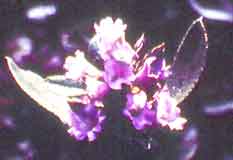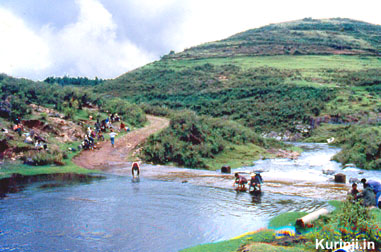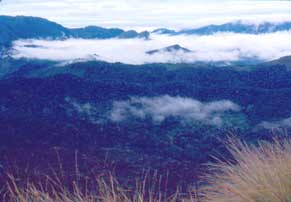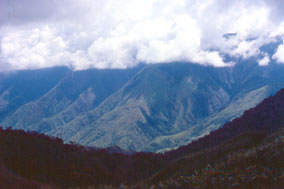 Roy
Mathew recalls the 1989 Save Kurinji March....
Roy
Mathew recalls the 1989 Save Kurinji March....
Tholkapiar sang about them centuries ago-- of neelakurinji plants that blossoms
like a carpet over the mountain peaks once in 12 years. That romantic blossom
may not be there in the next century for the future generations to sing about.
For that plant is today the part of a dying ecosystem.
A group of nearly 40
men and women set out from Kodaikanal on foot in September 1989 to have a look
at the plant and campaign against its destruction. There were young and old
from Mahe and eight districts of Kerala. Some activists of the Palani Hills
Conservation Council, Kodaikanal,including like C. J.John; a native of Hyderabad, Israel
Bhooshi, and a few English women joined them for one or two days walk. They returned
before the march reached its destination-- Munnar, across the Palani hills.
It was on the Palani Hills that neelakurinji was last found in abundance.
 G.Rajkumar
and others of the Asambu Greens, Trivandrum, who wre behind the spontaneous
organisation of the march, were not only concerned about the ecosystem but were
also sentimental about the kurinji plants. Mr. Anand Felix Skaria of the
Sahyadri Ecology Education Documentation (SEED) and P. K. Uthaman, Field Publicity
Officer, Government of India, saw the gradual disappearance of the plant as indication of irreversible
degradation of the shola grasslands. This was mainly on account of the raising
of plantations of eucalyptus and pines.
G.Rajkumar
and others of the Asambu Greens, Trivandrum, who wre behind the spontaneous
organisation of the march, were not only concerned about the ecosystem but were
also sentimental about the kurinji plants. Mr. Anand Felix Skaria of the
Sahyadri Ecology Education Documentation (SEED) and P. K. Uthaman, Field Publicity
Officer, Government of India, saw the gradual disappearance of the plant as indication of irreversible
degradation of the shola grasslands. This was mainly on account of the raising
of plantations of eucalyptus and pines.
Rajkumar and Uthaman were
witness to massive flowering of kurinji across the peaks in 1982 along with
K. V. Surendranath, Velayudhan Nair and Suresh Elamon--
a phenomenon that would recur in 1994 and 2006. That is, if the plants remain.
For under the shade of the plantations, they were disappearing.
 The
first day’s trek was the toughest for the group. Heavy rains retarded
their progress across the hills and dales between Kodaikanal and Poompara.They
could not reach Kavunji, where they were to spend the night, before nightfall.
Therefore, they had to get into the main road and reach poondi by vehicle.
The
first day’s trek was the toughest for the group. Heavy rains retarded
their progress across the hills and dales between Kodaikanal and Poompara.They
could not reach Kavunji, where they were to spend the night, before nightfall.
Therefore, they had to get into the main road and reach poondi by vehicle.
Poondi is a small village.
But it was one of the links in the ganja trail going to Kodaikanal. A youth
from the village introduced himself to a participant of the march and promised
to supply ganja wherever he wanted. The youth said he had sold ganja in Kottayam
and Ernakulam.
Enquires showed that ganja
was being cultivated in the deep jungles on both sides of the trekking path.
The officials are bribed to get forestland for cultivation. The running rate
in Tamil Nadu for this is Rs. 5000 an acre while one has to pay Rs. 100 per
plant in Kerala. Each plant when harvested would fet the cultivator Rs. 1000
to Rs. 3000 depending on the yield. Forests are destroyed indiscriminately to
cultivate ganja and armed men keep guard for the harvest.
 The
path from Poondi to Munnar goes through plantations of pines, eucalyptus and
wattle. The marchers got ponies at Klavara to help them with their luggage on
their climb. Near the top of the hills, men were seen planting eucalyptus on
the slopes. As a symbolic gesture of protest, a few youth in the group uprooted
ten eucalyptus seedlings in a nursery. This was bitterly opposed by the others
who did not believe that such actions would be of any help in protecting the
environment. There was also strong opposition to any sample collection.
The
path from Poondi to Munnar goes through plantations of pines, eucalyptus and
wattle. The marchers got ponies at Klavara to help them with their luggage on
their climb. Near the top of the hills, men were seen planting eucalyptus on
the slopes. As a symbolic gesture of protest, a few youth in the group uprooted
ten eucalyptus seedlings in a nursery. This was bitterly opposed by the others
who did not believe that such actions would be of any help in protecting the
environment. There was also strong opposition to any sample collection.
The first specimens of
the kurinji plant were found near the nursery close to the Kerala Tami1nadu
border. The crest lines of the mountains marked the boundary. As one crossed
the mountain peaks into Kerala forest territory, more and more kurinji plants
were seen. They survived in the open areas in between the trees in the wattle
plantations. However, under older plantations with wider canopy, the proportion
of kurinji plants was lower. They also looked unhealthy and diseased.
They were failing to survive
in the shade and in the soil rendered increasingly acidic by the tannin in the
falling leaves of the wattle tress. In a congenial environment, the plants would
attain a height of up to six feet. The plantations had robbed the region of
the natural environment, beauty and character.
 The
bees that produced the famous Kurinjithen (sweet honey obtained during the flowering
season of kurinji) were still there. But what had happened to the laughing thrushes,
brown mantil and Nilgiri pigeons that inhabit the grasslands?
The
bees that produced the famous Kurinjithen (sweet honey obtained during the flowering
season of kurinji) were still there. But what had happened to the laughing thrushes,
brown mantil and Nilgiri pigeons that inhabit the grasslands?
The destruction of the
grasslands is of immediate concern to those living down hills. Many of the rivers
flowing down to Tamil Nadu and Kerala originate in the shola grasslands of the
Western Ghats. The grasslands have a very high capacity to retain water and
release them gradually. Covered most of the time with mist, 20 per cent of the
water they receive is precipitated as dew throughout the year. The stream originating
from the grasslands are perennial but with the destruction of the grasslands,
they are beginning to dry up.
The climb down the hills
to Koviloor offers scenic views of the valleys below. There are no plantations
along a short stretch near the village. Then it is again plantations
up to the top Station at Munnar.
On the third day, the High
Range Wildlife Preservation Association, an organisation of the managers of
the tea estates there, received the marchers. They arranged for an interaction
of of the marchers with the Muthuvan tribes and school children. A meeting and
slide show were held under the auspices of the Nature Club, Munnar. The marchers
discussed future course of action to protect the grasslands.
 The
kurinji grasslands, they noted, are a national heritage with links to the culture
of the people in the region. The Government should initiate steps to protect
them by declaring the area as a sanctuary. Scientists, forest officials and
environmental activists should undertake a joint verification to determine the
boundaries. Steps should be taken to prevent fires.
The
kurinji grasslands, they noted, are a national heritage with links to the culture
of the people in the region. The Government should initiate steps to protect
them by declaring the area as a sanctuary. Scientists, forest officials and
environmental activists should undertake a joint verification to determine the
boundaries. Steps should be taken to prevent fires.
The Munnar Wildlife Preservation
Association and the Palani Hills Conservation Council, it was felt, would be
able to play an increased role for the protection of the shola grasslands.
The marchers dispersed
the next day after a visit to the Eravikulam National Park with the resolve
that they would come back for a more intense campaign the next year.
 G.Rajkumar
and others of the Asambu Greens, Trivandrum, who wre behind the spontaneous
organisation of the march, were not only concerned about the ecosystem but were
also sentimental about the kurinji plants. Mr. Anand Felix Skaria of the
Sahyadri Ecology Education Documentation (SEED) and P. K. Uthaman, Field Publicity
Officer, Government of India, saw the gradual disappearance of the plant as indication of irreversible
degradation of the shola grasslands. This was mainly on account of the raising
of plantations of eucalyptus and pines.
G.Rajkumar
and others of the Asambu Greens, Trivandrum, who wre behind the spontaneous
organisation of the march, were not only concerned about the ecosystem but were
also sentimental about the kurinji plants. Mr. Anand Felix Skaria of the
Sahyadri Ecology Education Documentation (SEED) and P. K. Uthaman, Field Publicity
Officer, Government of India, saw the gradual disappearance of the plant as indication of irreversible
degradation of the shola grasslands. This was mainly on account of the raising
of plantations of eucalyptus and pines. Roy
Mathew recalls the 1989 Save Kurinji March....
Roy
Mathew recalls the 1989 Save Kurinji March.... The
first day’s trek was the toughest for the group. Heavy rains retarded
their progress across the hills and dales between Kodaikanal and Poompara.They
could not reach Kavunji, where they were to spend the night, before nightfall.
Therefore, they had to get into the main road and reach poondi by vehicle.
The
first day’s trek was the toughest for the group. Heavy rains retarded
their progress across the hills and dales between Kodaikanal and Poompara.They
could not reach Kavunji, where they were to spend the night, before nightfall.
Therefore, they had to get into the main road and reach poondi by vehicle. The
path from Poondi to Munnar goes through plantations of pines, eucalyptus and
wattle. The marchers got ponies at Klavara to help them with their luggage on
their climb. Near the top of the hills, men were seen planting eucalyptus on
the slopes. As a symbolic gesture of protest, a few youth in the group uprooted
ten eucalyptus seedlings in a nursery. This was bitterly opposed by the others
who did not believe that such actions would be of any help in protecting the
environment. There was also strong opposition to any sample collection.
The
path from Poondi to Munnar goes through plantations of pines, eucalyptus and
wattle. The marchers got ponies at Klavara to help them with their luggage on
their climb. Near the top of the hills, men were seen planting eucalyptus on
the slopes. As a symbolic gesture of protest, a few youth in the group uprooted
ten eucalyptus seedlings in a nursery. This was bitterly opposed by the others
who did not believe that such actions would be of any help in protecting the
environment. There was also strong opposition to any sample collection. The
bees that produced the famous Kurinjithen (sweet honey obtained during the flowering
season of kurinji) were still there. But what had happened to the laughing thrushes,
brown mantil and Nilgiri pigeons that inhabit the grasslands?
The
bees that produced the famous Kurinjithen (sweet honey obtained during the flowering
season of kurinji) were still there. But what had happened to the laughing thrushes,
brown mantil and Nilgiri pigeons that inhabit the grasslands? The
kurinji grasslands, they noted, are a national heritage with links to the culture
of the people in the region. The Government should initiate steps to protect
them by declaring the area as a sanctuary. Scientists, forest officials and
environmental activists should undertake a joint verification to determine the
boundaries. Steps should be taken to prevent fires.
The
kurinji grasslands, they noted, are a national heritage with links to the culture
of the people in the region. The Government should initiate steps to protect
them by declaring the area as a sanctuary. Scientists, forest officials and
environmental activists should undertake a joint verification to determine the
boundaries. Steps should be taken to prevent fires.